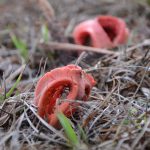
Valentine’s Day is just a few days away and this month’s theme is evidenced by the color red. Red hearts, bows, roses (imported this time of year from South America) and candy in red boxes
This hue is not frequently seen in Wakulla County in the mist of winter’s grip, but this year azaleas bloomed in January. Still, red highlights in lawns, pastures and other open areas tend to attract attention.
Mature Column Stinkhorns are in striking contrast to most other local mushrooms. These were growing on the edge of the UF/IFAS Wakulla County Extension Demonstration Garden where wood chips are plentiful.
Photo: Les Harrison
The reason is simple. A mushroom species is taking advantage of the cool weather and available moisture.
Clathrus columnatus, the scientific name for the column stinkhorn, is a north Florida native which is common to many Gulf Coast locales. This colorful fungus has also been known by the common name “dead man’s fingers”.
The short lived above ground structure is usually two to six inches high at maturity. This area is known as the fruiting body and produces spores which are the basis for the next generation.
Two to five hollow columns or fingers project upwards above the soil or mulch. Coloration of the fruiting body can range from pink to red, and occasionally orange.
The inner surfaces of the column are covered with stinkhorn slime and spores, and which produces an especially repulsive stench. This foul odor is useful though, attracting an assortment of flies and other insects which track through it.
A small amount of the mixture of the brown slime and spores attaches to the insect’s body. It is then carried by these discerning visitors to other bug enticing spots, usually of equal or greater offensiveness to people. Spores are deposited as the slime mixture is rubbed off as the insects brush against surfaces.
Decaying woody debris is a favorable environment for the column stinkhorn to germinate. As the wood rots bacterial activity makes necessary nutrients available to this mushroom.
Other areas satisfactory for development include lawns, gardens, flower beds and disturbed soils. All contain bits and pieces of decomposing wood and bark.
Occasionally, column stinkhorns can be seen growing directly out of stumps and living trees. Presence on a living tree is a good indication the tree has serious health issues and may soon die.
This fungi starts out as a partially covered growth called a volva. The portion above and below the soils surface has the general appearance of a hen’s egg and is bright white.
The term volva is applied in the technical study of mushrooms, and used to describe a cup-like structure at the base of the fungus. It is one of the precise visible features used to identify specific species.
The cool wet weather currently in Wakulla County combined with local sandy soils and available nutrients create ideal growing conditions. While rarely notices during initial stages of growth, they are quickly spotted at or near maturity.
There are other stinkhorn mushrooms in Wakulla County, but they are not as common. In addition to North America, member of this fungi family with a fetid aroma can be found in Europe, Asia, South America and Australia.
While not likely to be a Valentine’s Day gift, it still has a distinct place in the local environment. Get close and it is difficult to overlook.
To learn more about Wakulla County’s mushrooms, contact your UF/IFAS Wakulla Extension Office at 850-926-3931 or http://wakulla.ifas.ufl.edu/
 0
0


